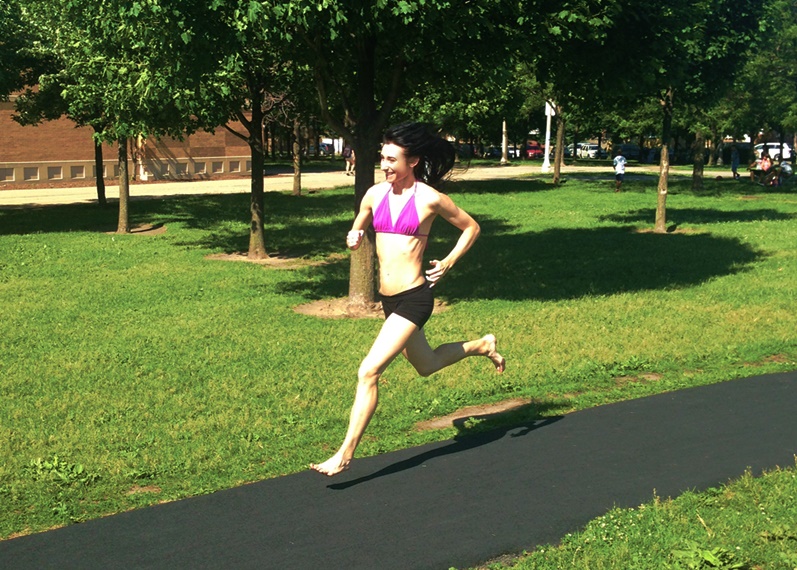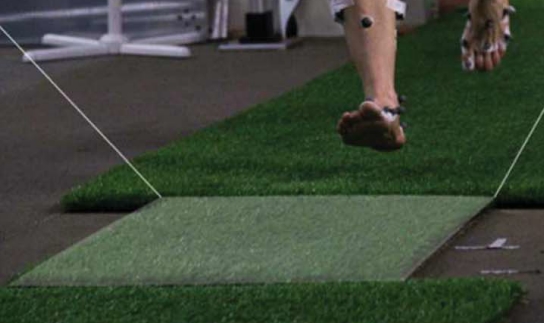Don’t be intimated of running barefoot on pavement. Its actually more comfortable than you think. You might think that running barefoot on pavement would hurt and cause injury, but it is actually less abusive on your body as compared with running in thick, cushioned running shoes.
Running barefoot on pavement is very important because it helps you land on your forefoot, rather than your heel, and research now shows that running barefoot on grass, especially if you are an inexperienced barefoot/forefoot runner, is the wrong idea. Learning forefoot running on softer surfaces may prevent you from optimizing your forefoot strike mechanics, especially if you were a long-standing heel striker.

How Running Barefoot On Pavement Improves Your Running Form
Why Soft Running Surfaces are Bad
Forefoot running on softer surfaces changes leg geometry at touchdown compared to forefoot running on hard surfaces. Willwacher et al., (2014) found that habitually shod heel strike runners who switched to barefoot running landed with a more posterior, not anterior foot strike pattern on soft running surfaces. This is interesting because barefoot running often encourages a forefoot strike over a heel strike.
- The researchers found that the barefoot runners landed with a less flat foot position with an increased ankle-joint dorsiflexion and reduced knee flexion on softer running surfaces.
Why did softer running surfaces encourage heel strike running-related mechanics?

Shorten and Mientjes (2011) speculate that softer running surfaces reduce or even eliminate the plantar stimulus needed to change foot strike geometry at touchdown during running.
In other words, softer running surfaces allow heel striking to feel more comfortable as compared with harder running surfaces.
Another downside to softer running surfaces is that the level of comfort it provides actually increases ground contact time, giving more time for plantar forces to distribute over more areas of the foot which may increase the risk of bone fatigue in the metatarsals. This is why heel strikers who transition to barefoot running or shod forefoot running should do so on hard surfaces.
Why Hard Running Surfaces are Safer
In the same study, the barefoot runners landed with a flatter foot geometry (plantarflexed ankle) with greater knee flexion on hard surfaces, suggesting that hard running surfaces provide a better opportunity for forefoot striking to adaptively prevent pressure peaks under the heel. Moreover, Tessutti et al., (2010) found that running on harder surfaces such as asphalt reduced ground contact time by 12% compared to running on grass.
The Take Home Message
The findings indicate that barefoot runners do not appear to suffer any ill effects from hard running surfaces. The discomfort of barefoot running with a heel strike on hard surfaces is the perfect motivator to prompt a proper forefoot strike landing for optimal comfort, the way running should feel: comfortable.
More From Run Forefoot:
- Why Runners Injure
- Forefoot Running Performance
- Center Mass in Forefoot Running
- Vibram Five Fingers Improve Back Pain
References:
De Wit, B., De Clercq, D., and Aerts, P., 2000. Biomechanical analysis of the stance phase during barefoot and shod running. J of Biomech, 33, 269–278.
Shorten, M. and Mientjes, M.I.V., 2011. The ‘heel impact’ force peak during running is neither ‘heel’ nor ‘impact’ and does not quantify shoe cushioning effects. Footwear Sci, 3, 41–58.
Tesutti et al. In-shoe plantar pressure distrubtion pattern during running on natural grass and asphalt in recreational runners. J Sci Med Sport, 2010; 13, 151-55.
Willwacher et al. The effect of shoes, surface conditions and sex on leg geometry at touchdown in habitually shod runners. Footwear Sci, 2014; 6(4):130-38.
Bretta Riches
BSc Neurobiology; MSc Biomechanics candidate, ultra minimalist runner & founder of RunForefoot. I was a heel striker, always injured. I was inspired by the great Tirunesh Dibaba to try forefoot running. Now, I'm injury free. This is why I launched Run Forefoot, to advocate the health & performance benefits of forefoot running and to raise awareness on the dangers of heel striking, because the world needs to know.
Latest posts by Bretta Riches (see all)
- Can You Run In Barefoot Shoes? Yes, But DON’T Heel Strike! - 21/07/2024
- Why Cushioned Running Shoes Are Really Bad for Your Feet - 19/07/2024
- Do Cushioned Running Shoes Cause Injuries? - 17/07/2024

Leave a Reply